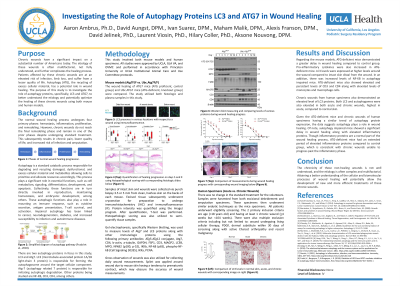Laboratory Research
(LR-024) Investigating the Role of Autophagy Proteins LC3 and ATG7 in Wound Healing

Aaron Ambrus, PhD – UCLA; David Aungst, DPM – UCLA; Maham Malik, DPM – UCLA; Jonathan Thompson, DPM; David Jelinek, PhD; Eric Lee, DPM; Laurent Viosin, PhD; Hilary Coller, PhD; Aksone Nouvong, DPM
Introduction: Chronic wounds have a significant impact on a substantial number of Americans today. The etiology of these wounds is often multifactorial and not fully understood, which further complicates the healing process. Typical wound healing undergoes 4 stages: hemostasis, inflammation, proliferation, and remodeling. Chronic wounds do not progress through all 4 stages and often fail standard therapy. Patients affected by these chronic wounds are at an elevated risk of infection, limb loss, and suffer from a lesser quality of life. Autophagy (ATG), the recycling of excess cellular material, has a potential role in wound healing. The purpose of this study is to investigate the role of autophagy proteins, LC3 and ATG7, to better understand the etiology and potentially optimize the healing of these chronic wounds.
Methods: Mouse models have been used in this study, which compared Ubc.ATG7 mice (ATG-deficient, knockout group) and ATG7 mice (ATG proficient, control group). Serum and tissue samples were harvested and underwent immunohistochemistry, immunofluorescence, and gel electrophoresis. Gross observation of wound healing was also compared. Similar methods have also been performed on human specimens collected from consented volunteers who have chronic wounds and/or underwent amputation. There was no change to the standard of care during treatment.
Results: ATG-deficient mice had a greater delay in wound healing compared to the control. Pro-inflammatory cytokines, monocytes, CD3, and CD4 lymphocytes were increased in ATG-deficient mice. LC3 levels and autophagosomes were also present at greater levels in chronic wounds compared to normal skin of mice. With human samples, LC3 levels were lowest in normal skin, higher in chronic wounds, and highest in acute wounds.
Discussion: The chronicity of these non-healing wounds is not well understood, and the etiology is often complex and multifactorial. Delayed wound healing was observed in ATG-deficient mice. The ATG-deficient group also had an elevated number of immune cells and inflammatory cytokines. Autophagy proteins were also elevated in chronic and acute wounds compared to normal skin. A better understanding of the cellular and biomolecular processes of wound healing will potentially develop more effective and efficient treatments for these chronic wounds.
Trademarked Items:
References:
Methods: Mouse models have been used in this study, which compared Ubc.ATG7 mice (ATG-deficient, knockout group) and ATG7 mice (ATG proficient, control group). Serum and tissue samples were harvested and underwent immunohistochemistry, immunofluorescence, and gel electrophoresis. Gross observation of wound healing was also compared. Similar methods have also been performed on human specimens collected from consented volunteers who have chronic wounds and/or underwent amputation. There was no change to the standard of care during treatment.
Results: ATG-deficient mice had a greater delay in wound healing compared to the control. Pro-inflammatory cytokines, monocytes, CD3, and CD4 lymphocytes were increased in ATG-deficient mice. LC3 levels and autophagosomes were also present at greater levels in chronic wounds compared to normal skin of mice. With human samples, LC3 levels were lowest in normal skin, higher in chronic wounds, and highest in acute wounds.
Discussion: The chronicity of these non-healing wounds is not well understood, and the etiology is often complex and multifactorial. Delayed wound healing was observed in ATG-deficient mice. The ATG-deficient group also had an elevated number of immune cells and inflammatory cytokines. Autophagy proteins were also elevated in chronic and acute wounds compared to normal skin. A better understanding of the cellular and biomolecular processes of wound healing will potentially develop more effective and efficient treatments for these chronic wounds.
Trademarked Items:
References:

.png)